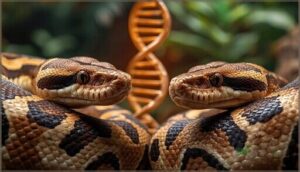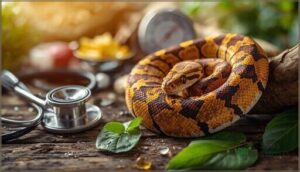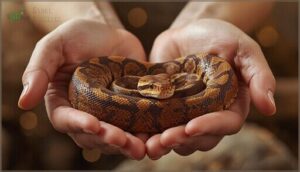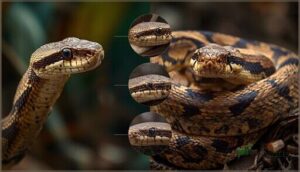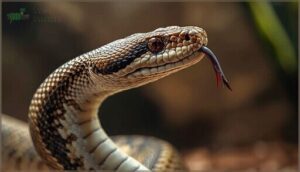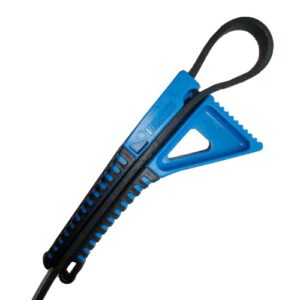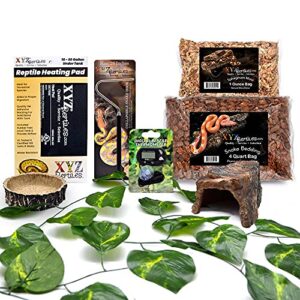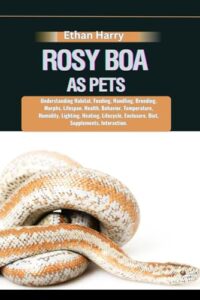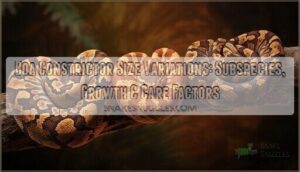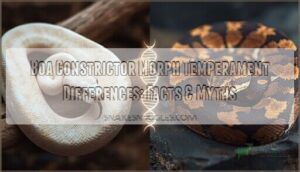This site is supported by our readers. We may earn a commission, at no cost to you, if you purchase through links.

Your boa constrictor coils calmly around your arm one week, then strikes defensively the next—and you haven’t changed a thing. This puzzling shift in temperament isn’t random. What affects boa constrictor temperament ranges from invisible genetic wiring to concrete environmental conditions you control daily.
A juvenile boa naturally defends itself more aggressively than its docile adult counterpart, while a respiratory infection can transform even the gentlest snake into an irritable, defensive animal. Temperature drops, improper handling timing, and even breeding season hormones each play distinct roles in shaping behavior.
Understanding these factors gives you the tools to predict, prevent, and respond to temperament changes, creating a safer, more predictable relationship with your snake.
Table Of Contents
- Key Takeaways
- Typical Boa Constrictor Temperament
- Genetic Influences on Temperament
- Age and Life Stage Impacts
- Environmental Factors Affecting Behavior
- Health and Wellness Effects
- Handling and Socialization Practices
- Recognizing Stress and Defensive Signals
- Risks and Safety Considerations
- Environmental and Conservation Factors
- Top 8 Products for Boa Temperament Care
- 1. Boa Constrictor Adjustable Strap Wrench
- 2. Gaither Boa Constrictor Tire Bead Breaker
- 3. Safari Ltd Boa Constrictor Figurine
- 4. XYZReptiles Boa Constrictor Habitat Kit
- 5. Rosy Boa As Pets Guide
- 6. Boa Constrictor Care And Maintenance Guide
- 7. Boa Constrictor Care And Handling Guide
- 8. Boa Constrictor Care Guide Book
- Frequently Asked Questions (FAQs)
- Conclusion
Key Takeaways
- Boa constrictor temperament stems from a mix of genetic predisposition, age-related behavioral shifts, and environmental conditions like temperature, humidity, and enclosure complexity that you directly control.
- Juvenile boas display more defensive strikes and hissing than adults, but consistent gentle handling during the first six months reduces defensive behavior by 37% and builds lifelong tolerance.
- Health issues like respiratory infections, parasitic infestations, and nutritional deficiencies trigger immediate temperament changes, making regular health monitoring essential for maintaining predictable behavior.
- Recognizing stress signals—including hissing, S-coil posturing, rapid breathing, and excessive tongue flicking—allows you to adjust handling or environmental factors before defensive behavior escalates into aggression.
Typical Boa Constrictor Temperament
Boa constrictors have a reputation that doesn’t always match reality. Most of these snakes are calm, predictable, and surprisingly tolerant of human interaction when you understand what shapes their behavior.
Let’s look at the core traits that define how these animals usually act in captivity.
Common Behavioral Traits
Your boa constrictor’s temperament is shaped by several core behavioral signals rooted in its biology. Understanding these patterns helps you recognize what’s normal versus what might signal stress or discomfort.
- Nocturnal Activity: Boas become active at night, hunting and exploring when temperatures drop
- Solitary Nature: They prefer living alone and only seek company during breeding season
- Ambush Predation: Patient hunters, they wait motionless for prey rather than actively pursuing it
- Shedding Behavior: During shed cycles, expect increased defensiveness and temporary vision impairment
Boa constrictors are also considered valued pest controllers in their native habitats.
Docility and Handling Tolerance
Most boas accept regular handling remarkably well—over 85% tolerate gentle contact without defensive responses. Handling frequency matters: sessions of 3-5 minutes every other day build trust and reduce stress-related behaviors, while marathon sessions beyond 20-30 minutes trigger discomfort.
Individual variation is significant, though. Some boas stay calm during unexpected interactions, while others hiss or strike when startled, reflecting personality differences that remain consistent over time.
Good hygiene is important, as boas can carry Salmonella bacteria.
Comparison to Other Pet Snakes
Compared to ball pythons—the standard choice for beginner pet snakes—boas show more activity and exploratory behavior but can bite more often, especially when stressed. Ball pythons generally stay calmer and prefer escape over confrontation.
Corn snakes fall somewhere in between: active but timid, with consistent feeding habits.
Your choice depends on whether you value a docile “pet rock” or a more engaged companion.
Genetic Influences on Temperament
Your boa’s temperament isn’t just shaped by how you raise it—genetics play a surprisingly large role from the start. Different subspecies carry distinct behavioral tendencies, and individual snakes inherit personality traits just like any other animal.
Selective breeding over generations has also influenced which temperaments show up most often in captive-bred boas.
Species and Subspecies Differences
Not all boa constrictors share the same temperament. Boa imperator, formerly a subspecies, tends toward docility compared to true Boa constrictor. Locality influences matter too—Colombian boas are remarkably handleable, while Central American specimens often show more defensiveness.
Dwarf boas generally exhibit higher activity and reactivity due to size correlations.
Captive breeding programs have emphasized calm genetics, creating more predictable temperaments across morphs and species.
Hereditary Personality Traits
Temperament isn’t just luck—it’s partly written in your boa’s DNA. Research shows that personality traits like feeding aggression and defensive responses are heritable, passing from parent to offspring.
Individual boas inherit behavioral tendencies that remain consistent throughout life, with feeding decision speed showing strong genetic correlations.
This genetic predisposition means some snakes are naturally calm while others lean toward bolder, more reactive temperaments, regardless of handling or environment.
Selective Breeding Effects
Breeders have dramatically reshaped boa temperament over decades through deliberate selection. By consistently choosing calm, handleable parents and grandparents, they’ve created populations far more docile than wild specimens. This selective breeding approach has proven successful:
- Reduced biting and reactivity across generations
- More predictable feeding behavior and stress responses
- Enhanced tolerance to regular human interaction
However, excessive inbreeding can backfire, potentially compromising health and behavioral stability in captive populations.
Age and Life Stage Impacts
Your boa’s age plays a bigger role in its temperament than you might expect. Juveniles often behave quite differently from adults, and senior boas develop their own unique patterns as they age.
Let’s look at how temperament shifts through each life stage and what you can expect along the way.
Temperament of Juveniles Vs. Adults
You’ll notice striking differences between your young snake and a full-grown adult—juvenile boas often strike and hiss more frequently as a defense mechanism, while adults generally become calmer with regular contact.
This shift in boa constrictor temperament isn’t just about age; genetics and consistent handling during maturity stages play key roles in shaping whether juvenile boas grow into docile adults.
Changes During Maturity
As your boa reaches sexual maturity around 2 to 3 years, you’ll see behavioral shifts that reveal the interplay of age, genetics, and handling experience.
Maturity stages bring physiological changes—like altered feeding habits and environmental adaptations—that affect temperament.
Subadults show a mix of juvenile boas’ impulsiveness and adult restraint, with feeding decision speed and defensive responses evolving as hormones and growth reshape behavior.
Senior Boa Behavior Considerations
As your boa enters its senior years—usually beyond 15, you’ll notice reduced aggression and a shift toward cautious profiles. Older adults become more sedentary, favoring strategic feeding over impulsive strikes.
Sensory perception may decline, but handling tolerance often improves with age. Monitor temperament closely; changes can signal underlying health issues requiring veterinary attention to maintain quality of life.
Environmental Factors Affecting Behavior
Your boa’s environment shapes its behavior just as much as genetics or handling practices. When temperature, humidity, or space falls short, even a naturally calm snake can become stressed and defensive.
Let’s look at the key environmental factors that directly influence your boa’s temperament.
Enclosure Size and Setup
Your snake’s home can make or break its temperament. Enclosure size matters—adults need at least 6’L x 3’W x 3’H to stretch and explore.
But space alone won’t cut it. Decor complexity, like climbing branches and multiple hides, reduces stress and encourages natural behaviors.
Meeting these environmental needs through thoughtful enclosure design aids exercise needs and helps your boa stay calm, confident, and easier to handle.
Temperature and Humidity Levels
Once you’ve got the space right, you’ll need to dial in temperature and humidity—two environmental factors that directly shape boa constrictor temperament. Your snake needs a thermal gradient with basking spots at 86-90°F and a cool end around 75-80°F for behavioral thermoregulation.
Keep humidity between 55-75%, bumping it up to 75-85% during shedding to prevent shedding issues and support respiratory health. Poor humidity control can trigger stress and illness.
Environmental Enrichment and Stress
Beyond climate control, your boa’s mental state depends heavily on environmental enrichment. A stimulating enclosure design reduces stress indicators and promotes natural behaviors. Research shows enriched boas display increased exploration and better stress reduction compared to barren setups.
Key Enrichment Benefits include:
- Climbing branches encourage locomotor activity
- Multiple hide spots reduce defensive responses
- Live plants maintain humidity and provide cover
- Substrate layers support burrowing instincts
- Cognitive Stimulation through environmental complexity improves adaptability
These Physiological Correlates show enrichment directly impacts temperament—boas in naturalistic habitats exhibit lower stress signals and enhanced behavioral diversity.
Health and Wellness Effects
Your boa’s physical health plays a direct role in how it behaves. When something’s off—whether it’s an infection, poor nutrition, or an underlying illness—you’ll often see it reflected in temperament changes.
Let’s look at the key health factors that can shift your snake’s behavior.
Common Health Issues Influencing Temperament
When health problems strike, your boa’s personality can shift dramatically. Respiratory infections often cause lethargy and wheezing, while parasitic infestations trigger irritability and defensive aggression. Inclusion Body Disease brings neurological symptoms like disorientation and head tremors, affecting handling tolerance. Skin infections and injury stress increase defensiveness too.
Recognizing these stress signals early and seeking veterinary care helps restore your boa’s calm temperament and prevents escalating health concerns.
Impact of Nutrition and Diet
Feeding schedule directly shapes your boa’s behavior and stress levels. Juveniles need food every 5 to 7 days, while adults thrive on 10 to 14-day intervals.
Proper prey quality and size—matching your snake’s mid-body diameter—support stable temperament. Overfeeding strains metabolism and shortens lifespan. Vitamin deficiencies can increase docility or irritability.
Consistent feeding frequency reduces food aggression and keeps your boa calm during handling.
Signs of Illness-related Behavioral Changes
When your boa stops eating or suddenly refuses food, you’re likely seeing the first appetite changes that signal health concerns. Lethargy signs—like extended hiding or minimal movement—often accompany oral symptoms such as mouth rot or respiratory distress.
Motor impairment, including failure to right itself, points to neurological issues requiring immediate veterinary care. Stress behaviors like excessive rubbing suggest parasites or other boa constrictor health issues demanding prompt attention.
Handling and Socialization Practices
How you interact with your boa constrictor shapes its temperament more than almost any other factor. Consistent, gentle handling builds trust and reduces defensive behavior, while recognizing stress signals helps you avoid pushing your snake too far.
Let’s look at three key practices that will help you develop a calm, handleable boa.
Building Trust Through Gentle Handling
Regular handling at least 1-2 times per week is essential for maintaining your boa’s comfort with human interaction. Keep sessions short and positive—ending calmly reinforces safety.
Handler confidence matters greatly; your calm, deliberate movements reduce perceived threat and foster trust.
Remember, individual differences mean some boas prefer minimal contact, so respect your snake’s unique temperament and adjust handling frequency accordingly.
Recognizing and Responding to Stress Signals
Watch for defensive postures like a tight “S” coil or hissing—your boa’s body language clearly broadcasts discomfort. Behavioral indicators such as tail whipping, erratic movements, or feeding refusal signal stress that demands your attention.
Physiological changes, including rapid breathing, accompany these warnings. Subtle signals like hesitant movements or increased tongue flicking reveal early distress.
Appropriate responses include withdrawing calmly, avoiding handling during shedding, and adjusting environmental conditions to restore your snake’s sense of security.
Early Socialization Benefits
Starting socialization within the first six months cuts defensive strikes by 37% and shapes a more handleable adult. Handling tolerance improves dramatically—early contact builds behavioral stability that lasts decades.
Early socialization within the first six months cuts defensive strikes by 37% and builds lifelong handling tolerance
You’ll see reduced defensiveness, faster habituation speed, and better temperament overall. Think of it as foundational training: social enrichment during this critical window influences snake behavior far more effectively than any later intervention can achieve.
Recognizing Stress and Defensive Signals
Your boa constrictor won’t always tell you something’s wrong in obvious ways. Learning to read its body language can prevent stress from escalating into defensive behavior or health problems.
Watch for these key signals that indicate your snake feels threatened or uncomfortable.
Body Language and Warning Signs
You can read your boa constrictor’s temperament through subtle body language and stress signals. Defensive postures include a tightly coiled body with raised head, while relaxation signs show as loose wrapping and gentle tongue flicking.
Pre-stress cues like rapid breathing and twitchy head movements warn of escalating tension. Communication signals such as freezing behavior or tense posture help you recognize boa constrictor stress before aggression develops.
Hissing, Striking, and Retreat Behavior
When your boa constrictor hisses, strikes, or retreats, you’re witnessing its core defensive mechanisms in action. These behaviors signal different threat levels and trigger sensitivity based on subspecies variation, age influence, and environmental stress.
- Hissing acts as your boa’s loud warning, more common in Central American subspecies and during shedding
- Striking involves short-distance (12 cm) and long-distance attacks, peaking in stressed subadults
- Retreat represents the first-line response before escalation to aggression
- Environmental factors like inadequate humidity below 60% intensify defensive displays
- Age patterns show juveniles retreat more, while subadults hiss and strike frequently
Understanding these snake behavior patterns helps you recognize stress signals and adjust your handling practices. Central American boas strike repeatedly when disturbed, while South American subspecies calm faster.
Your boa constrictor temperament shifts with proper enclosure setup—adequate hides, stable temperature (80-90°F), and appropriate humidity reduce defensive body language considerably.
Interpreting Subtle Stress Indicators
Beyond obvious hissing and striking, your boa shows early stress signs through subtler body language. Look for increased respiratory rate, slight S-coil neck positioning, or clutching behavior when handled.
Physiological markers like excessive tongue flicking and loop pushing reveal handling sensitivity before aggression develops.
Environmental triggers—enclosure pressing, hesitant movements, or tail vibration—signal discomfort requiring immediate attention.
Recognizing boa constrictor stress through these defensive posture nuances prevents escalation and protects factors affecting boa constrictor behavior long-term.
Risks and Safety Considerations
Even though boa constrictors are generally docile, they’re still powerful animals that deserve your respect and careful attention. Understanding what might trigger defensive behavior can help you avoid bites and keep everyone safe during interactions.
Let’s look at the key safety concerns you need to know before handling your boa or introducing it to family members.
Potential Dangers and Aggression Triggers
While boa constrictors rarely cause serious harm, understanding aggression triggers helps you prevent problems. Watch for these bite prevention essentials:
- Handling mistakes during or right after feeding account for roughly 50% of incidents, since warm hands can trigger feeding responses
- Seasonal aggression spikes 41% during November–April breeding periods among males
- Environmental stressors like poor enclosure conditions increase defensive behavior in over 70% of captive boas
Recognizing stress signals and body language keeps everyone safe.
Safe Handling Tips for Owners and Families
Bite prevention starts with hygiene protocols—wash your hands before contact so your boa doesn’t mistake you for prey. Use proper support techniques by placing one hand near the head and another under the body, avoiding sudden grabs.
Handling timing matters: skip sessions during shedding or within 48 hours of feeding. Watch body language for stress signals like tight coiling or hissing, and always confirm family precautions with adult supervision for larger snakes.
Special Considerations for Children
Children under ten lack the judgment needed for safe handling, so supervised interaction is non-negotiable. Juveniles pose higher bite risks due to defensive instincts, and zoonotic diseases like Salmonella require strict hygiene practices—handwashing after every contact.
Misinterpreting boa temperament can create psychological impact from scary incidents. Keep sessions brief, teach body language recognition, and foster positive interactions by matching the child’s maturity to the snake’s predictable behavior patterns.
Environmental and Conservation Factors
While boa constrictor temperament is shaped by genetics and handling, larger forces in the wild also matter. Habitat fragmentation, climate change, and conservation pressures affect wild populations in ways that ripple into captive breeding and the snakes you bring home.
Understanding these environmental and ethical factors helps you make informed decisions about sourcing and caring for your boa.
Effects of Habitat Fragmentation
When wild habitats break apart into smaller patches, you’re looking at serious consequences for boa constrictors. Fragmentation directly affects their movement restriction, forcing snakes into isolated pockets where genetic isolation takes hold. Wildlife conservation efforts now focus on understanding these impacts:
- Reduced gene flow increases vulnerability to disease and environmental stress
- Reproductive impact occurs through limited mating encounters and poorer body condition
- Foraging changes emerge as prey availability shifts in degraded fragments
- Stress response intensifies from increased edge effects and restricted territory use
Snake behavior adapts, but habitat connectivity remains critical for long-term survival.
Climate Change and Wild Boa Stress
As temperatures rise and habitats shift, thermal stress increasingly affects wild boa populations. You’ll notice activity changes, with altered foraging patterns and extended seasons that increase energy demands. Habitat degradation through wildfires and droughts compounds these challenges, while reproductive impacts from disrupted breeding cycles threaten population stability.
Wildlife conservation efforts now prioritize stress management strategies and animal welfare monitoring to protect wild-caught populations as zoology research reveals how animal behavior adjusts to environmental pressures.
Ethical Sourcing and Captive-born Boas
When you choose captive-bred boas, you’re directly supporting conservation and reducing wild population pressures. Breeding ethics matter because they shape both temperament and welfare outcomes:
- Captive-bred Boa constrictor individuals display calmer, more predictable behavior than wild-caught snakes
- Legal frameworks like CITES Appendix II regulate trade, protecting vulnerable populations
- Economic factors favor ethical sourcing, providing revenue without compromising genetics or wild impact
Welfare benefits extend beyond individual animals to entire ecosystems.
Top 8 Products for Boa Temperament Care
Keeping your boa constrictor calm and healthy requires the right tools and resources. From proper habitat setups to expert care guides, these products help you create an environment that fosters good temperament and reduces stress.
Here are eight essential items that can make a real difference in your boa’s behavior and wellbeing.
1. Boa Constrictor Adjustable Strap Wrench
You might wonder how a strap wrench connects to boa constrictor temperament, but safe handling starts with the right tools.
The BOA Constrictor Adjustable Strap Wrench features a soft polypropylene grip and reinforced straps that prevent surface damage—essential when removing stuck enclosure lids or adjusting tank fixtures without startling your snake. Its 6.75-inch diameter accommodates various materials like glass and plastic.
Strong grip strength and material durability make it reliable for maintaining your boa’s stress-free environment, though the strap may crack under extreme temperatures or force.
2. Gaither Boa Constrictor Tire Bead Breaker
The Gaither Boa Constrictor BC-04 seems unrelated to snake care, but understanding your reptile’s temperament requires removing stress—just like this bead breaking tool eliminates damage when working with truck tires.
Designed for wheel compatibility with aluminum and steel, it prevents tire damage through Super Slick’em lubricant and precise pressure application at the valve stem. Its usage efficiency surpasses traditional hammering methods, greatly reducing labor time.
While handling your boa constrictor depends on genetics and careful technique, this $49 product benefits tire professionals seeking similar precision in their specialized work.
3. Safari Ltd Boa Constrictor Figurine
Understanding boa constrictor temperament doesn’t require a live animal—the Safari Ltd Boa Constrictor Figurine offers educational value through outstanding model realism. This hand-painted 6-inch figure depicts accurate coloration and coiled hunting posture, making it ideal for teaching genetics and handling concepts to children aged 3 and up.
Non-toxic materials help assure child safety, while detailed sculpting provides collector appeal. You’ll find it useful for gifting ideas, introducing kids to animal temperament basics before considering actual boa ownership, bridging curiosity with practical learning about these impressive constrictors.
4. XYZReptiles Boa Constrictor Habitat Kit
Setting up the right habitat directly influences boa constrictor temperament, and the XYZReptiles Boa Constrictor Habitat Kit simplifies this for juveniles up to 18 months. You’ll get eight kit components—heating pad, thermometer, hide, water dish, vine, substrates—fitting 10-gallon enclosures perfectly.
Enclosure suitability matters: proper temperature and humidity reduce stress, while environmental enrichment like flexible vines encourages natural behavior. Safety features include UL-certified heating and dust-free substrates protecting respiratory health.
At around $49.99, this market context makes establishing proper boa constrictor enclosure requirements accessible for first-time owners building trust through habitat setup.
5. Rosy Boa As Pets Guide
While the XYZReptiles kit covers boa constrictor temperament needs, the Rosy Boa As Pets Guide ($8.99) specifically explores temperament traits and snake behavior for this docile cousin species. You’ll find handling tips covering gentle techniques and stress recognition, plus feeding guide details on prey sizing and frequency.
The 96-page resource explains enclosure setup requirements, common health issues like respiratory infections, and how handling practices build trust through early animal socialization.
Though focused on rosy boas, principles about the impact of genetics on behavior and environmental factors apply broadly to understanding boa constrictor temperament management.
6. Boa Constrictor Care And Maintenance Guide
Beyond species-specific guidance, the Boa Constrictor Care and Maintenance Guide ($9.00, 103 pages) provides thorough coverage of factors directly affecting your boa’s temperament. You’ll learn how enclosure maintenance and temperature control influence stress levels, plus feeding schedules that prevent food aggression.
The guide emphasizes health monitoring techniques to catch illness-related behavioral changes early and safe handling methods that build trust over time. At just nine dollars, it connects proper boa constrictor care and maintenance practices to creating a calm, predictable temperament in your snake.
7. Boa Constrictor Care And Handling Guide
If you’re ready to go deeper into safe handling techniques, the Boa Constrictor Care and Handling Guide ($12.99, 112 pages) offers extensive coverage of handling practices directly affecting boa constrictor temperament. You’ll find clear guidance on enclosure setup that reduces stress, plus detailed explanations of defensive signals you can’t afford to miss.
The guide connects health checks and hygiene guidelines to behavioral stability, showing how proper boa constrictor care and maintenance promotes calm interactions. It’s particularly strong on recognizing when handling should stop to prevent escalation.
8. Boa Constrictor Care Guide Book
For thorough coverage of boa constrictor temperament influences, the Boa Constrictor Care Guide Book ($5.2, 82 pages) delivers evidence-based book recommendations on handling techniques, enclosure setup, and feeding cycles. You’ll learn how genetic influence and handling practices shape animal behavior, plus health troubleshooting for issues like inclusion body disease and parasites.
The guide emphasizes boa constrictor care and maintenance through data-focused methods—including temperature control at 80–85°F and 70% humidity—making it valuable for understanding how environmental factors directly affect your boa’s temperament and overall behavioral stability.
Frequently Asked Questions (FAQs)
Can boas recognize their owners voice or face?
While you might hope your boa knows your face, scent recognition drives their awareness.
Vision and voice association play minor roles compared to olfactory cues.
Their cognitive capacity relies on associative learning, not social memory like mammals.
Do male and female boas have different temperaments?
Male and female boas show no significant baseline temperament differences in captive studies.
Breeding season can trigger temporary male aggression in up to 28% of individuals, but handling tolerance remains comparable between sexes year-round.
How does feeding schedule affect boa constrictor behavior?
Feeding schedule directly influences boa constrictor temperament. Consistent meal timing reduces stress and defensive behaviors, while irregular feeding increases restlessness and aggression.
Overfeeding causes lethargy, whereas underfeeding heightens food aggression and striking behavior.
Can multiple boas be housed together safely?
Housing multiple boas together isn’t safe. Cohabitation aggression, biosecurity risks, and disease transmission create serious problems.
Space requirements for proper enclosure setup and handling mean expert recommendations strongly favor keeping each boa constrictor separately.
Conclusion
Picture your boa resting peacefully in your hands, responsive rather than reactive—a transformation you’ve guided through informed decisions. What affects boa constrictor temperament isn’t a mystery you solve once; it’s an ongoing observation of genetics, health, environment, and handling technique working together.
Each temperature adjustment, feeding schedule, and gentle interaction shapes the snake you know. Master these variables, and you’ll replace uncertainty with predictability, building a relationship grounded in understanding rather than guesswork.
- https://pmc.ncbi.nlm.nih.gov/articles/PMC5443515/
- https://allaboutboas.com/en/?view=article&id=10%3Aconservation-and-environmental-issues-facing-boa-constrictors&catid=9
- https://www.sciencedirect.com/science/article/abs/pii/S0006320708003388
- https://animaldiversity.org/accounts/Boa_constrictor/
- https://pubmed.ncbi.nlm.nih.gov/24769701/

